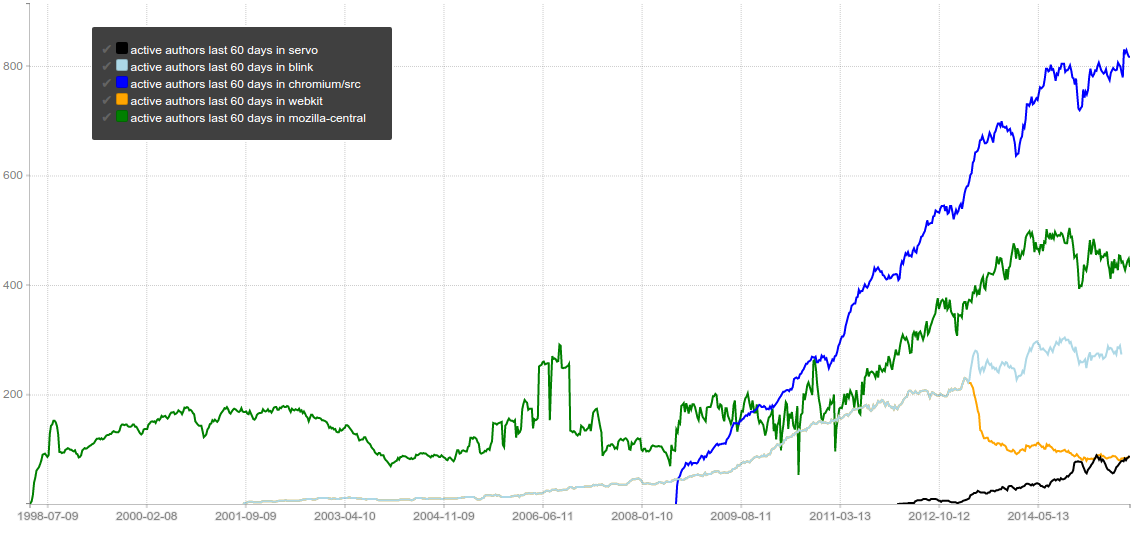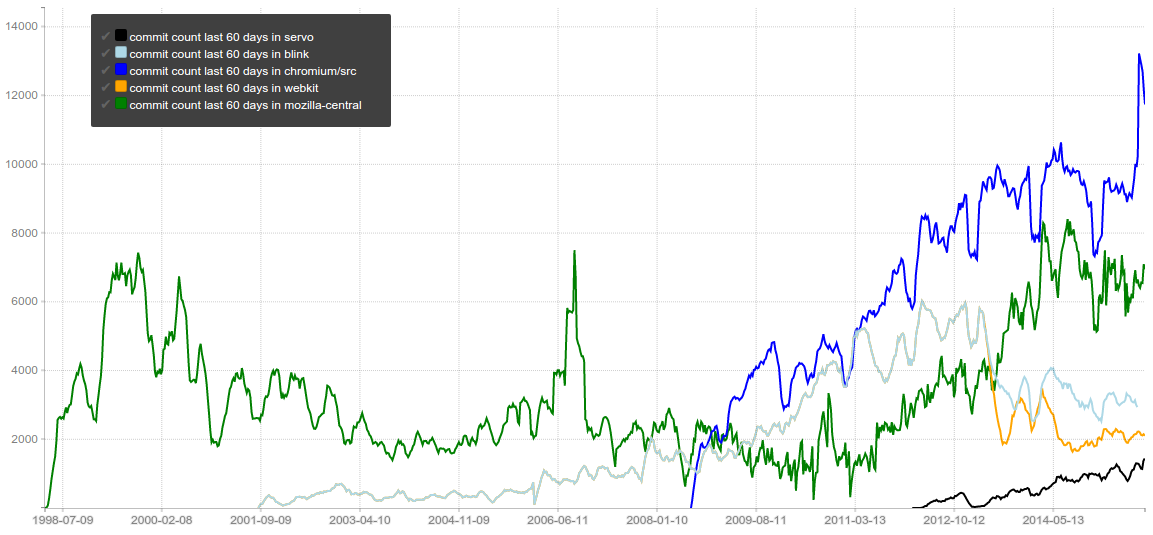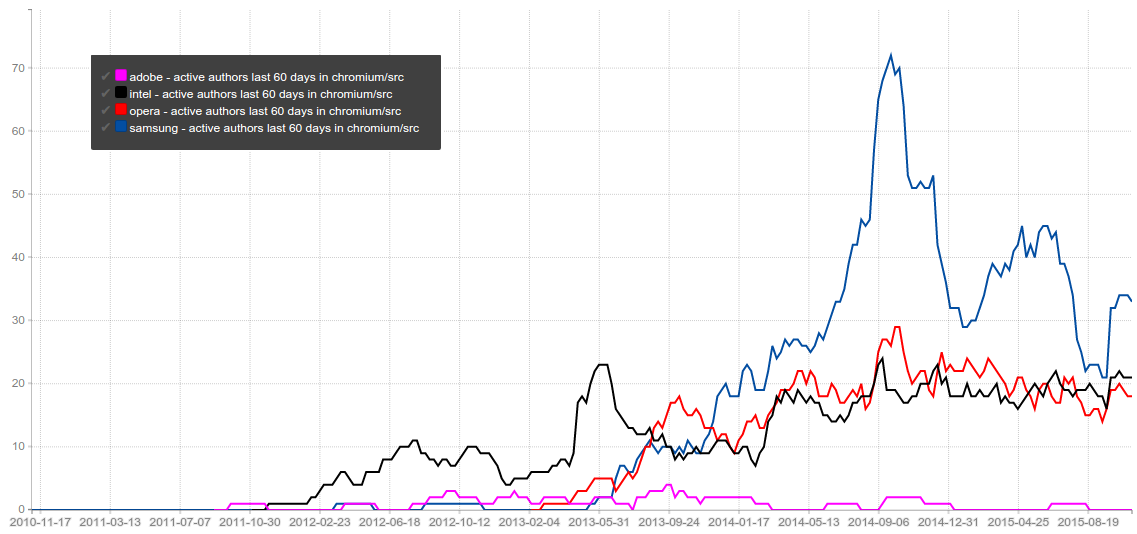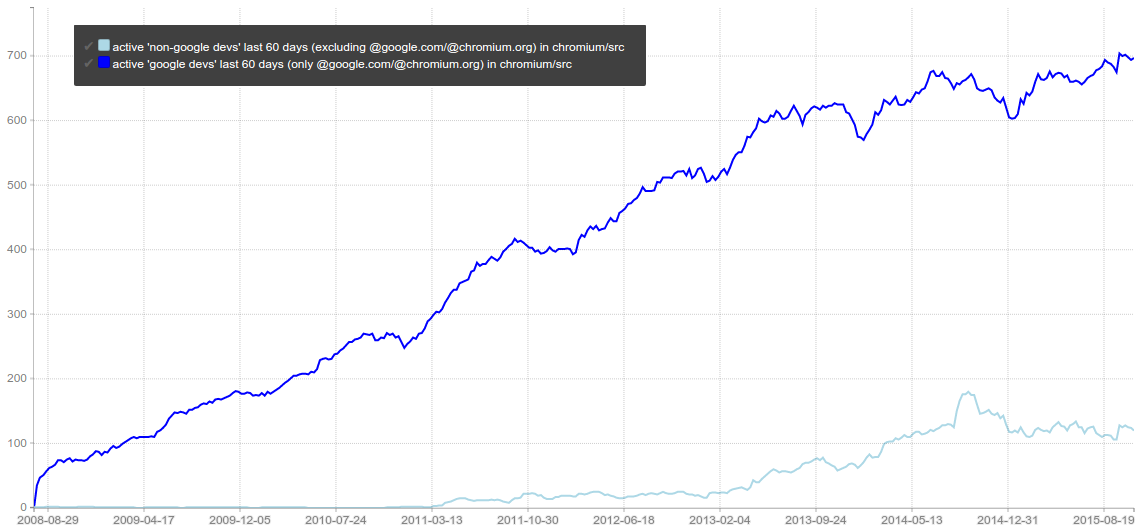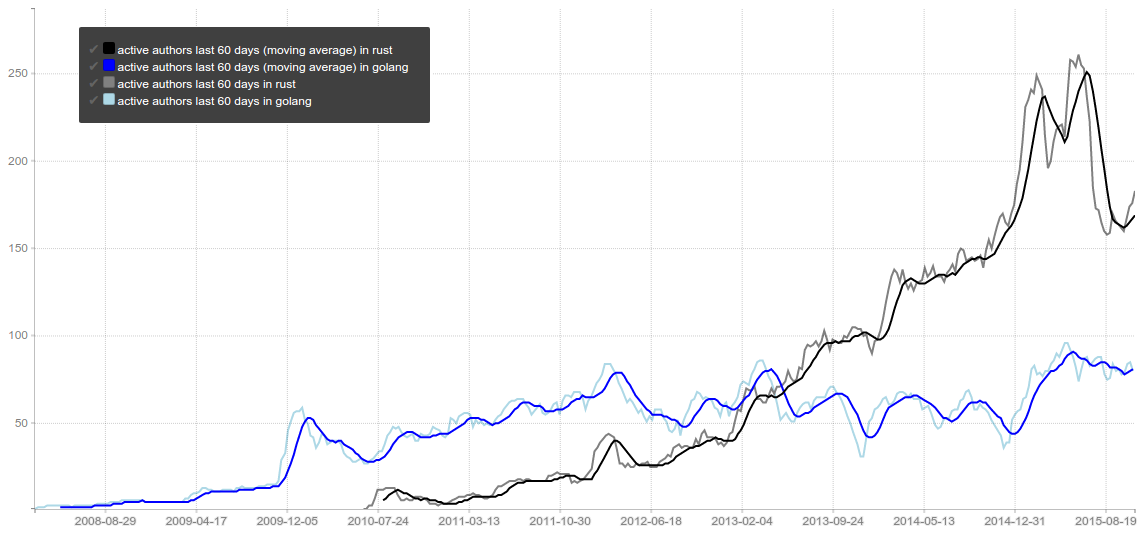Browser Engines 2015: Commit Rates and Active Developer Counts
I used to work as a developer in the “core” group at Opera that developed the Presto web engine. During this period, I often wondered just how many developers Google and Mozilla had working on their codebases and how that number changed over time. I was also curious about how pace of development changes as a code base aged (the first versions of Opera and Chrome came out in 1995 and 2008 respectively).
I hacked together a couple of scripts that analyzes browser engine source repositories in order to extract data on the number of developers and commit rates. Originally my data included numbers for Opera as well but they are “closed source” and very careful not to reveal the number of developers they have on each team; so I had to drop those numbers from the graphs (although, of course they were a large part of the reason why I wrote these scripts in the first place).
Finally, a quick caveat; these repositories contain slightly different kinds of things and some projects make few but big commits and some make a lot of small ones (e.g. “add feature”, “fix bug”, “fix bug”, “fix bug”). And you know, “lies, damned lies, and statistics” yada yada.
This first graph shows the number of unique developers working on mozilla-central, chromium, webkit, blink and servo. For example, if N different developers make at least one commit each during April and May, then for X={30th of May} the graph is showing Y=N.
Some notable things about the graph above:
-
Google has a lot of developers working on chromium (approximately twice as many as mozilla has working on mozilla-central).
-
Up until mid-2014 Google was relentlessly adding more developers to the project, but after that the trend stopped and instead the number of developers working on chromium has been constant.
-
The webkit/blink fork shows up clearly in this graph (webkit is the yellow line and blink is the light blue line).
-
October 2015 was the first time ever when servo had more developers than webkit. As we shall see later on, webkit is still a bit ahead of servo in terms of commit rate but I certainly think it’s impressive that servo has managed to recruit as many developers as they have.
-
There is a tiny spike upwards in the developer count of blink just after the fork from webkit; I looked into the specifics of this and it turns out that this was a bunch of google developers that switched from committing using @webkit.org addresses to committing using @chromium.org addresses instead (my script thinks foo@webkit.org and foo@chromium.org are 2 unique developers; so those guys got counted twice during 60 days following the fork, hence the spike). It should be noted that my scripts are aware of the fact that foo@chromium.org and foo@google.com are almost always the same developer so commits from those two addresses would still just count as one developer.
-
The really early numbers from mozilla-central and webkit should be taken with a grain of salt. CVS and Subversion doesn’t track author and committer separately so if one developer wrote a patch and a committer cleaned it up + merged it, then the non-committer developer isn’t really visible at all. Also I wasn’t paying close attention to browser engines that early on so I havn’t been able to judge if those numbers are even remotely plausible or not.
The second graph shows the number of commits in mozilla-central, chromium, webkit, blink and servo during a 60 day period. Again, as an example; if there are N commits during April and May, then for X={30th of May} the graph is showing Y=N.
-
In some sense, this graph paints a more true picture of the webkit/blink fork; it shows the fact that Google and Apple were both strong contributors to webkit and after the fork none of them have gotten anywhere near the previous rate of change.
-
The gigantic spike upwards for chromium around 22 sept 2015 is real in the sense that the the numbers of commits landing in chromium increased a lot overnight, but this was actually the blink repository being discontinued (instead blink became a directory inside the chromium repository so in reality it’s mostly a book-keeping change).
-
You can also see regular drops in the commit rate of chromium; this is Christmas holiday breaks showing up in the data. It’s interesting that these drops are not as clear in the data from mozilla-central. I wonder if this is because chromium is more of a “corporate gig” and mozilla has a certain labor of love element to it? :-)
-
For mozilla-central you can see a clear trend change (mostly flat commit rate turning into a steadily increasing commit rate) around 2011-06-20 which happens to coincide with the release of Firefox 5 and the transition to the mozilla rapid release schedule (the 6 week thing). The number of active developers in mozilla-central started to grow a lot at that time too. Maybe they got access to more funding or something? If someone knows for sure what activated this change of pace for the mozilla project, please post a comment below.
Now for the third graph, I just decided to divide the number of commits by the number of developers:
The first thing I thought about when I saw this graph was that mozilla, chrome and webkit all started out quite high and then it was downhill from there on (in terms of commits/dev). I hid the servo graph because the graph got too cluttered, but it was the same thing there too. Maybe most large software projects dig themselves into a hole of complexity, and then get stuck in that hole and die slowly? Also, software projects tend to get more process heavy over time, raising the requirements in terms of commit queues, test passes and code reviews that the developers has to handle.
If you look more carefully, you can see that mozilla has actually bucked this trend for the last few years which is quite impressive. I think it’s notable how the graphs for mozilla, chrome and blink (and actually servo as well, although I dropped it from the image) all come in about about 10-15 commits per developer (for a 60 day period). Webkit was always the odd one out here, often landing at 25 commits/developer for a 60 day period, and as soon as Google took control of it via the blink fork the commits/developer metric immediately converged down to the “normal” level.
The fourth graph shows the active developer count for the largest non-google companies contributing to chromium:
Some notable things about the above graph are:
-
Intel and Opera have approximately the same number of developers working on Chromium, although Intel first started working on Chromium about 1 year earlier than Opera.
-
Samsung has a lot more developers working on Chromium compared to both Intel and Opera.
-
The number of developers Samsung has assigned to Chromium varies a lot, probably depending on the release schedule for their “Samsung Browser” and the phones that it ships on.
The fifth graph shows the number of active Chromium developers split into Google and non-Google groups:
The graph above shows that Google is still actually increasing the number of developers working on Chromium, just not at the same rate as before. Also, it becomes clear that the point when Google shifted down its hiring pace was not mid-2014 but rather it was already in May 2013 (which is still a full year after the market share of Chrome grew beyond Internet Explorer). The thing that makes the Google change invisible in the original “developer count” graph is in fact the slightly insane push that Samsung in mid-2014.
That’s the end of the browser stuff. Although, since I had written the scripts to generate these graphs, I could not resist running them on a few other repos. Below you can see commit rates for gcc vs llvm/clang:
This graph got a bit too cluttered (since I used just “commit count in the last 7 days” instead of the 60 days that I used above) and to fix it I experimented with another approach; I computed a 16 week rolling average (i.e. lightgreen is that actual commit rate in the gcc repo, while the darker green shows the rolling average). As you can see, llvm/clang surpassed gcc sometime around 2006-2009. FWIW, I also did a graph for inserted+deleted lines and there gcc is still mostly above llvm/clang actually.
Here is a graph showing active developers for gcc vs llvm/clang:
And finally, here is a graph showing active developer count for golang vs rust (also with a rolling average although it wasn’t really needed for this one):
If you want to look at these graphs in more detail, they are also available as interactive javascript graphs here.
The script that I used to generate these graphs is available at github.com/mo/git-source-metrics, although I havn’t had time to write any documentation etc so it’s probably not that useful to someone other than me.
